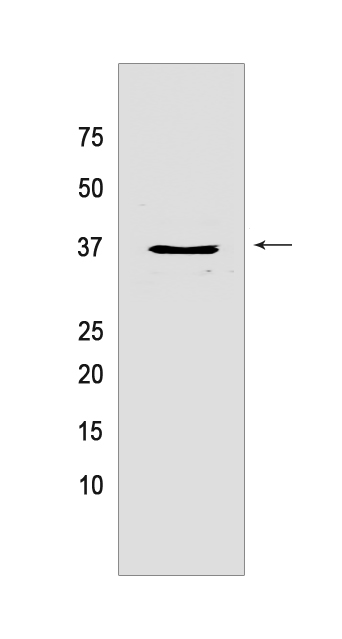AUH Rabbit mAb [HHDU]Cat NO.: A41129
Western blot analysis of extracts from Mouse brain tissue lyaste.using AUH Rabbit mAb [HHDU] at dilution of 1:1000 incubated at 4℃ over night
Product information
Protein names :AUH,AUHM_HUMAN,Methylglutaconyl-CoA hydratase, mitochondrial
UniProtID :Q13825
MASS(da) :35,609
MW(kDa) :36 kDa
Form :Liquid
Purification :Protein A purification
Host :Rabbit
Isotype :IgG
sensitivity :Endogenous
Reactivity :Human,Mouse,Rat
- ApplicationDilution
- 免疫印迹(WB)1:1000-2000
- 免疫荧光(ICC/IF)1:100,
- The optimal dilutions should be determined by the end user
Specificity :Antibody is produced by immunizing animals with a synthetic peptide of Human AUH.
Storage :Antibody store in 10 mM PBS, 0.5mg/ml BSA, 50% glycerol. Shipped at 4°C. Store at-20°C or -80°C. Products are valid for one natural year of receipt.Avoid repeated freeze / thaw cycles.
WB Positive detected :Mouse brain tissue lyaste
Function : Catalyzes the fifth step in the leucine degradation pathway, the reversible hydration of 3-methylglutaconyl-CoA (3-MG-CoA) to 3-hydroxy-3-methylglutaryl-CoA (HMG-CoA) (PubMed:12434311, PubMed:16640564, PubMed:11738050, PubMed:12655555). Can catalyze the reverse reaction but at a much lower rate in vitro (PubMed:16640564). HMG-CoA is then quickly degraded by another enzyme (such as HMG-CoA lyase) to give acetyl-CoA and acetoacetate (PubMed:16640564). Uses other substrates such as (2E)-glutaconyl-CoA efficiently in vitro, and to a lesser extent 3-methylcrotonyl-CoA (3-methyl-(2E)-butenoyl-CoA), crotonyl-CoA ((2E)-butenoyl-CoA) and 3-hydroxybutanoyl-CoA (the missing carboxylate reduces affinity to the active site) (PubMed:16640564). Originally it was identified as an RNA-binding protein as it binds to AU-rich elements (AREs) in vitro (PubMed:7892223). AREs direct rapid RNA degradation and mRNA deadenylation (PubMed:7892223). Might have itaconyl-CoA hydratase activity, converting itaconyl-CoA into citramalyl-CoA in the C5-dicarboxylate catabolism pathway (PubMed:29056341). The C5-dicarboxylate catabolism pathway is required to detoxify itaconate, an antimicrobial metabolite and immunomodulator produced by macrophages during certain infections, that can act as a vitamin B12-poisoning metabolite (PubMed:29056341)..
Subcellular locationi :Mitochondrion.
IMPORTANT: For western blots, incubate membrane with diluted primary antibody in 1% w/v BSA, 1X TBST at 4°C overnight.


